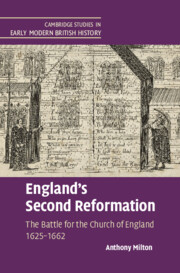Book contents
- England’s Second Reformation
- Cambridge Studies in Early Modern British History
- England’s Second Reformation
- Copyright page
- Dedication
- Contents
- Acknowledgements
- Abbreviations
- Introduction
- Chapter 1 An Unresolved Reformation
- Chapter 2 Situating the Laudian Reformation
- Chapter 3 Responses to the Laudian Reformation
- Chapter 4 The Abortive Reformation, 1640–1642
- Chapter 5 The End of Episcopalian Reformation
- Chapter 6 Reformation by Negotiation
- Chapter 7 The Westminster Reformation and the Parliamentarian Church of England
- Chapter 8 The Royalist Church of England, 1642–1649
- Chapter 9 Alternative Reformations, 1649–1653
- Chapter 10 The Cromwellian Church
- Chapter 11 Episcopalian Royalism in the 1650s
- Chapter 12 Failed Reformations, 1659–1661
- Chapter 13 The End of Comprehensive Reformation and the Caroline Settlement
- Conclusion
- Index
Chapter 13 - The End of Comprehensive Reformation and the Caroline Settlement
Published online by Cambridge University Press: 05 October 2021
- England’s Second Reformation
- Cambridge Studies in Early Modern British History
- England’s Second Reformation
- Copyright page
- Dedication
- Contents
- Acknowledgements
- Abbreviations
- Introduction
- Chapter 1 An Unresolved Reformation
- Chapter 2 Situating the Laudian Reformation
- Chapter 3 Responses to the Laudian Reformation
- Chapter 4 The Abortive Reformation, 1640–1642
- Chapter 5 The End of Episcopalian Reformation
- Chapter 6 Reformation by Negotiation
- Chapter 7 The Westminster Reformation and the Parliamentarian Church of England
- Chapter 8 The Royalist Church of England, 1642–1649
- Chapter 9 Alternative Reformations, 1649–1653
- Chapter 10 The Cromwellian Church
- Chapter 11 Episcopalian Royalism in the 1650s
- Chapter 12 Failed Reformations, 1659–1661
- Chapter 13 The End of Comprehensive Reformation and the Caroline Settlement
- Conclusion
- Index
Summary
Chapter 13 analyses the different forces that worked against the comprehensive religious settlement that was attempted in 1660-61. It begins with a study of conservative elements hostile to any compromise with Presbyterianism, noting their emphasis on the evils of sacrilege, and how the language of ‘restoration’ was often expressed in prophetic rather than conservative terms. It then discusses the Presbyterian opposition to a range of aspects of the new settlement – from the threat of reordination to the repudiation of the Solemn League and Covenant and the stricter imposition of liturgical conformity. While these problems were not insuperable, most puritans could find at least one feature of the new settlement that they considered non-negotiable. The chapter then analyses the settlement itself, and argues that it was not a simple restoration of the pre-war church, or of the Laudian church, but constituted a rather eclectic hybrid of different elements of the Church of England’s earlier identities. Its features could be glossed in different ways, and both the Clarendon Code and the 1667 agitation for a comprehension bill presented themselves as further rationalizations of the intended settlement. It is argued that the principles of the abortive reformation were not conclusively defeated in 1662.
Keywords
- Type
- Chapter
- Information
- England's Second ReformationThe Battle for the Church of England 1625–1662, pp. 479 - 506Publisher: Cambridge University PressPrint publication year: 2021

